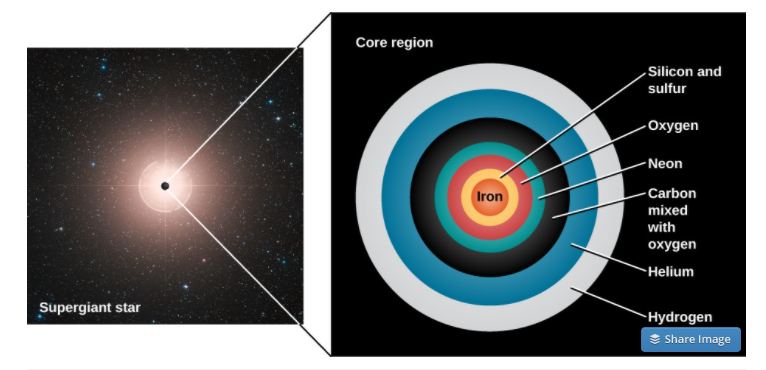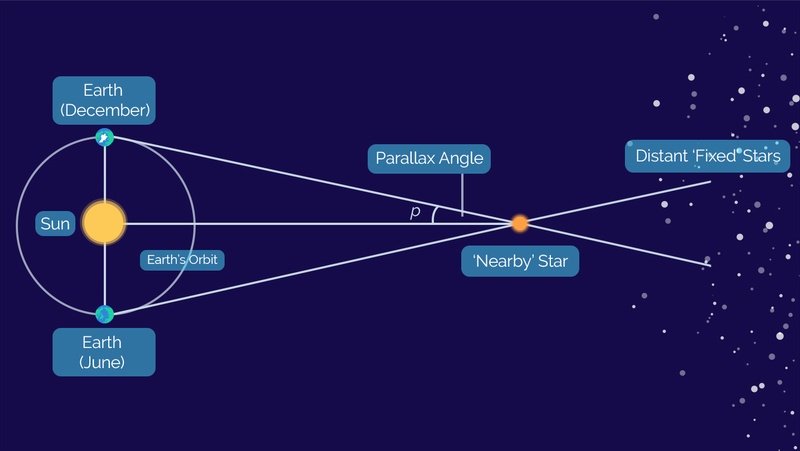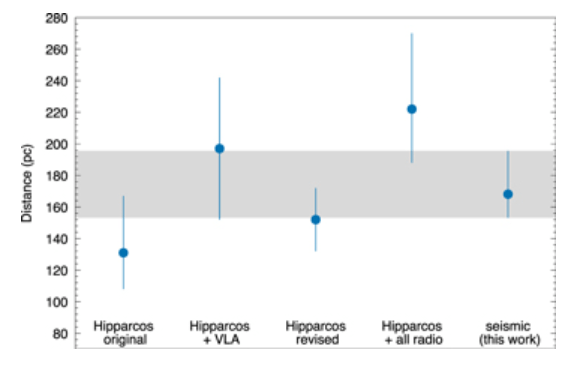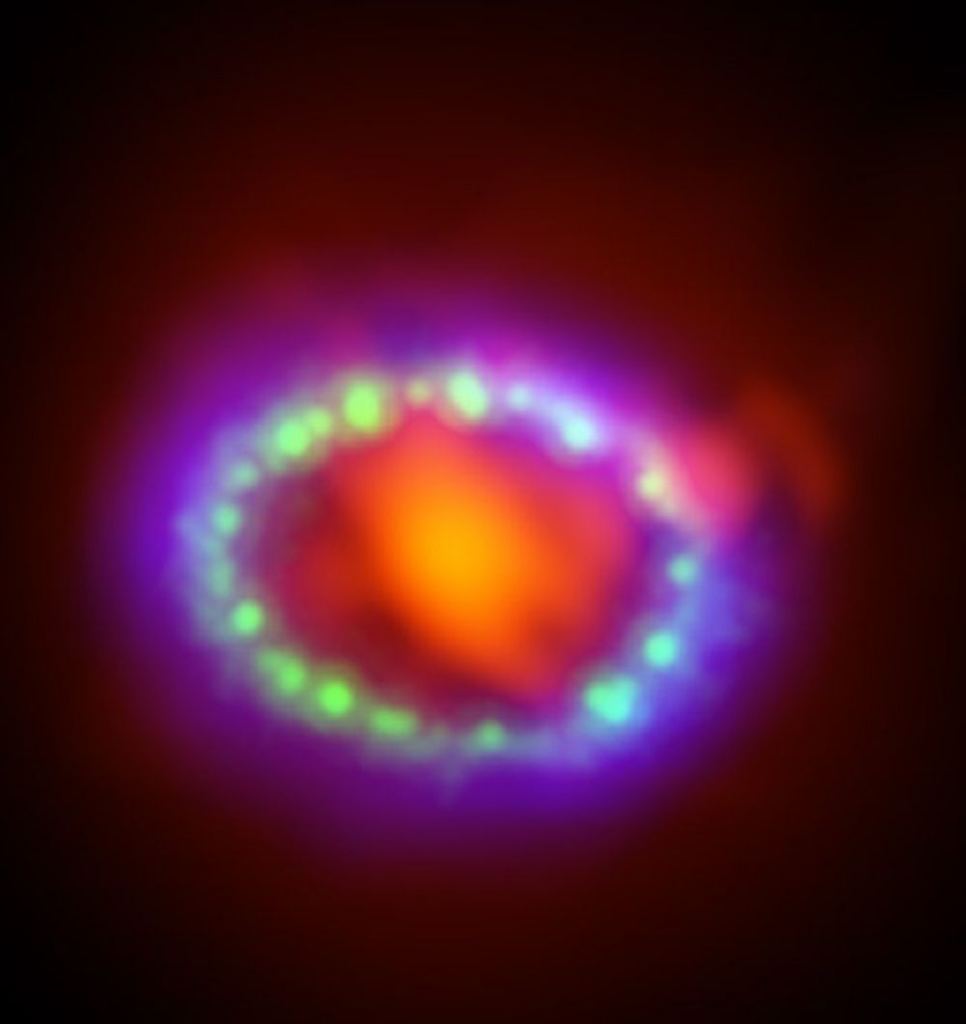In the last year, Betelgeuse has experienced two episodes of dimming. Normally, it’s one of the ten brightest stars in the sky, and astrophysicists and astronomers got busy trying to understand what was happening with the red supergiant. Different research came up with some possible answers: Enormous starspots, a build-up of dust, pre-supernova convulsions.
Now a new study is introducing another wrinkle into our understanding of Betelgeuse. The authors say that Betelgeuse is both smaller and closer than previously thought.
The new study is titled “Standing on the Shoulders of Giants: New Mass and Distance Estimates for Betelgeuse through Combined Evolutionary, Asteroseismic, and Hydrodynamic Simulations with MESA.” The lead author is Dr. Meridith Joyce, a postdoctoral fellow in stellar physics and galactic archeology at The Australian National University. The paper is published in The Astrophysical Journal.
Our fascination with Betelgeuse is not new. As the tenth brightest star in the sky, we can’t help but notice it. Betelgeuse is a variable star, and it’s the brightest star in the sky in the infrared. It’s in a prominent position in the Orion constellation, and its red hue has made it an object of fascination since antiquity.

As a variable star, Betelgeuse’s brightness changes sometimes. But starting late last year, the star exhibited some new behavior. First, it grew dimmer, weakening to only about 37% of its normal brightness in early February 2020. Then it brightened again until the end of May 2020. Then another episode of dimming began.
In this new paper, the authors wanted to “…conduct a rigorous examination of the nearby red supergiant Betelgeuse by drawing on the synthesis of new observational data and three different modeling techniques.” They performed hydrodynamic and seismic modeling to learn more about the physics driving Betelgeuse’s pulsations and get a clearer idea of what phase of its life Betelgeuse is in.
As a result, they were able to get a precise prediction for the star’s radius. They also got more accurate mass, distance, and periodicity measurements.
In a press release, Dr. Joyce said “It’s normally one of the brightest stars in the sky, but we’ve observed two drops in the brightness of Betelgeuse since late 2019. This prompted speculation it could be about to explode. But our study offers a different explanation.”
“We know the first dimming event involved a dust cloud. We found the second smaller event was likely due to the pulsations of the star,” Dr. Joyce explained.
According to these results, Betelgeuse is nowhere near exploding as a supernova. The star is still burning helium in its core, and an explosion is hundreds of centuries away.
“It’s burning helium in its core at the moment, which means it’s nowhere near exploding,” Dr. Joyce said. “We could be looking at around 100,000 years before an explosion happens.”
Red supergiants exhaust the helium in their cores in one or two million years. After that, they move to carbon fusion. Next, they fuse heavier and heavier elements until an iron core builds up. Then they inevitably collapse and explode as supernovae.

Accurate size and distance measurements for Betelgeuse have been difficult to obtain. In recent decades, different estimates have ranged from as little as 330 light-years away to as much as 650 light-years away. A recent 2017 study came up with 724 light-years (+111/-156.)
Knowing the distance to a star is one of the keys to understanding it. Without knowing the distance, we can’t know a star’s luminosity or its physical size. But it’s difficult to measure.
Astronomers rely on trigonometric parallax to gauge a star’s distance. To do that, they measure a star’s apparent motion. Apparent motion is how a star appears to move in relation to even more distant stars. It’s based on the Earth’s orbit around the Sun, which changes our observing location. The position of the target star changes, while the more distant stars don’t appear to move due to the great distance. The apparent motion is called stellar parallax, and it’s measured in arcsecs. The further away a star is, the smaller its parallax is in arcsecs.

One of the problems with parallax measurements is that the further away something is, the less accurate the measurement can be. For example, the nearest star to Earth is Proxima Centauri, and it has a parallax of only 0.772-arcsec, which is the largest parallax observed for any star. The measurements can be especially inaccurate if observing from the ground, where the Earth’s atmosphere can interfere.
In this study, the team used data from an instrument on the Coriolis Satellite. They also used asteroseismic data to constrain Betelgeuse’s radius. They used three separate models to interpret that data, and they arrived at a distance measurement of 548 (+88/-49) light-years away. Their measurement means that Betelgeuse is about 25% smaller and 25% closer than previously thought.

“The actual physical size of Betelgeuse has been a bit of a mystery – earlier studies suggested it could be bigger than the orbit of Jupiter,” said co-author Dr. László Molnár from the Konkoly Observatory?in Budapest. “Our results say Betelgeuse only extends out to two-thirds of that, with a radius 750 times the radius of the sun.”
“Once we had the physical size of the star, we were able to determine the distance from Earth. Our results show it’s a mere 530 light-years from us – 25 percent closer than previous thought,” said Molnár.
Despite some of the uncertainty around Betelgeuse’s behavior, distance, and size, its ultimate fate is clear. It will eventually explode as a supernova.

Astronomers suspect that ancient supernova played a role in the course of life on Earth, including triggering some partial extinctions. A supernova explosion about 360 million years ago during the Devonian Period may have triggered an extinction that wiped out up to 75% of all species on Earth.
Another supernova only 2.6 million years ago may have wiped out large marine animals, and another may have led to humans walking upright, though that result is anything but clear. But what is clear is that if a supernova explodes too near to Earth, it’s not good. A 2017 study showed that the supernova kill zone is within 50 light-years of Earth.
But when Betelgeuse blows, Earth will be safe. At 530 light-years away, the energy from the explosion will be widely dispersed before any of it reaches this planet. So instead of a catastrophe, it would be a fantastic cosmic light show and a cornucopia of scientific knowledge.
If any humans are still around then.
More:
- Press Release: Supergiant star Betelgeuse smaller, closer than first thought
- New Research: Standing on the Shoulders of Giants: New Mass and Distance Estimates for Betelgeuse through Combined Evolutionary, Asteroseismic, and Hydrodynamic Simulations with MESA
- Universe Today: Betelgeuse Probably Dimmed Because of Enormous Starspots

